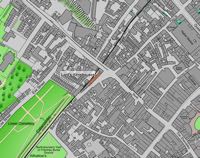
Lant's Almshouses
Page added 26th November 2015
 In 1408, Sir William Bonville, left several tenements in Exeter, and 300 marks, for the endowment of a hospital for twelve poor people. On the 20 May 1675, Richard Lant, the son of John Lant, Mayor in the 1611, conveyed to the feofees (trustees) of the Grendons (Ten Cells) and Bonville’s Almshouses, a farm of about sixty-eight acres, at Buckland in Dorset, the income from which, was to be used to supplement the income of the two almshouses. By about 1700, Bonville's had become dilapidated and unfit for habitation, while Grendons was in need of refurbishment–the unused rent from the endowments accumulated until 1763, when the feoffees negotiated with the City Chamber for new almshouses to be built.
In 1408, Sir William Bonville, left several tenements in Exeter, and 300 marks, for the endowment of a hospital for twelve poor people. On the 20 May 1675, Richard Lant, the son of John Lant, Mayor in the 1611, conveyed to the feofees (trustees) of the Grendons (Ten Cells) and Bonville’s Almshouses, a farm of about sixty-eight acres, at Buckland in Dorset, the income from which, was to be used to supplement the income of the two almshouses. By about 1700, Bonville's had become dilapidated and unfit for habitation, while Grendons was in need of refurbishment–the unused rent from the endowments accumulated until 1763, when the feoffees negotiated with the City Chamber for new almshouses to be built.
A site was found in Bartholomew Street, just between the Northgate and the already existing ‘Citty Almshouses’. It was probable that the existing almshouses were demolished for the new row of twelve almshouses. Chamber accounts recorded that the row of new almshouses cost £746, along with detailed payments to the various tradesmen. Each dwelling had a living room, with bedroom over, and at the rear a passage with scullery, water supply and water closet. The feoffees resigned their trust and handed the new development to the Chamber.
The residents received 3s 6d each per week in 1850. The farm left by Richard Lant was still let in 1850 for about £100 per year. In 1821, another £1,500 was held by the Corporation.
A few tales
Mr John Gil, the eighty two year old the city cryer, resided in Lant's Almshouses in 1879. He requested from the Council a small pension, having carried the cryer's bell for 48 years. The Council already paid him £5 per year as keeper of Bartholomew's Yard. It was recommended he be granted an additional £5 per year. In 1883 there were three married couples living at Lant's who received 6s per couple.
In September 1894, the Board of Charity Commissioners for England and Wales published a notice in the Western Times giving notice that a new scheme was to be introduced to administer many of Exeter’s almshouses, including Lant’s. By the 20th Century, Lant’s and others were administered by the Exeter Consolidated Almshouses and Pensions Trust.
A resident in 1885, Mrs Elizabeth Northam, was the victim of a a scam by a sixteen year old girl, who pretended to be the daughter of 'Squire Sanders'. She told the old woman she could supply her with a free rabbit or fowl which were in her carriage around the corner. She asked Mrs Northam to give her a shilling, so she could go and pay the boy holding the horse, and she would return with the rabbit/fowl. She was handed the coin and promptly disappeared. The girl had been touring the local almshouses with the same scam. She was committed for trial.
The homes for twelve poor people were inhabited until 1959, when they were demolished in the constant drive to widen Exeter’s roads. There are many in Exeter who still remember Lant’s, and some who even remember the tenants hanging over their split stable doors. All that remains is a strip of grass along the city wall between BurgerFest, in the old Malt House, and the site of the old Northgate.
Sources: Whites Directory 1850, Western Times and Exeter and Plymouth Gazette from The British Newspaper Archive.
 Lant's Almshouses in Bartholomew Street East.
Lant's Almshouses in Bartholomew Street East. The Sutton Nichols 1723 map showing the 'Citty Almshouses'. Lant's were not built until 1763.
The Sutton Nichols 1723 map showing the 'Citty Almshouses'. Lant's were not built until 1763.
│ Top of Page │